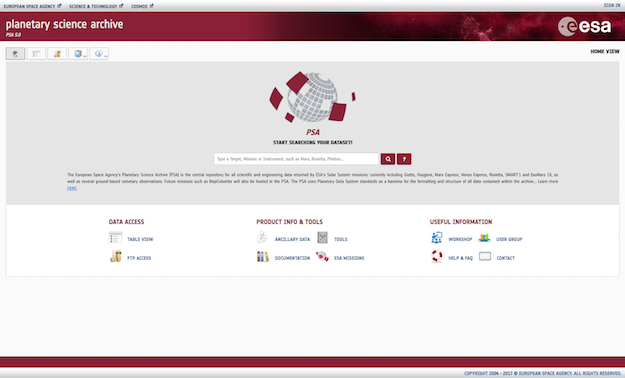.
THE NEW INTERFACE OF ESA'S PLANETARY SCIENCE ARCHIVE
 Home page of ESA’s Planetary Science Archive (PSA) website, the online interface to data from the agency's space science missions that have been exploring planets, moons and other small bodies in the Solar System.
Home page of ESA’s Planetary Science Archive (PSA) website, the online interface to data from the agency's space science missions that have been exploring planets, moons and other small bodies in the Solar System.
This PSA interface is based on advanced digital archive technology. The new design and a dynamic way to query data provide users with an improved, faster and more reliable experience than its predecessor.
The website, aimed at scientists who use observations from ESA's planetary missions for their research, contains science-ready data that have been calibrated by the instrument teams and peer-reviewed by independent experts in the scientific community, and are compliant with the Planetary Data System (PDS) standards.
---
ESA Planetary Science Archive gets a new look
ESA launches a new version of its Planetary Science Archive (PSA) website, the online interface to data from the agency's space science missions that have been exploring planets, moons and other small bodies in the Solar System. With a new design and enhanced search functionalities, the platform now provides a direct and simple access to the scientific data, helping scientists to discover and explore the archive content.
The interface is designed for scientists who use observations from ESA's planetary missions for their research. It contains science-ready data that have been calibrated by the instrument teams and peer-reviewed by independent experts in the scientific community. The observations are compliant with the Planetary Data System (PDS) standards to ensure long-term preservation of the dataset for at least ten years.
The revamped interface provides users with an improved, faster and more reliable experience thanks to the advanced digital archive technology that has been used. The new PSA features a new design and a dynamic way to query data. A variety of search and download options have been implemented to respond to different needs expressed by the user community.
Scientists can now browse the archive by selecting a specific mission, instrument or instrument type, as well as by choosing a specific science target object- for example, all available observations (from any instrument) of Mars, the Moon or Comet 67P/Churyumov-Gerasimenko. This new navigation feature enables cross-mission or cross-instrument searches through the archive. All of the data available from each mission can also be downloaded in bulk with a single click via the FTP function.
Users can request observations from a specific period in time and choose between raw or calibrated data. In the case of observations performed with imaging instruments, the new interface displays thumbnail images to facilitate the selection; a similar option, displaying a plot of the data, is available for other types of observations.
The archive encompasses over three decades of ESA's exploration of the Solar System, including data from currently operating missions, like Mars Express and ExoMars 2016 at the Red Planet; data from missions in the post-operations phase, such as the comet-chaser Rosetta (which also observed planets and two asteroids during flybys); and legacy data from completed missions such as Giotto which visited Comet 1P/Halley in 1986, SMART-1 which observed the Moon between 2003 and 2006, the Huygens probe of the international Cassini mission which landed on Saturn's largest moon, Titan, in 2005, and Venus Express, which operated at Venus from 2006 to 2014.
The database also contains observations of Comet 46P/Wirtanen, Rosetta's former target, that were performed with the NASA/ESA Hubble Space Telescope and a handful of ground-based telescopes to support the Rosetta mission, as well as ground-based observations of Comet 1P/Halley taken to support Giotto.
All these data - about 10 million individual observations so far, amounting to almost 50 terabytes in volume - are now available to the scientific community from one single interface.
The PSA team is also preparing for ESA missions currently in the implementation phase, like the Mercury explorer BepiColombo, with planned launch date in 2018, so that when observations are available in the future, they can be readily incorporated in the archive infrastructure.
"We are happy to have successfully implemented this update - a great collaboration between many scientists and engineers - in response to the needs of the planetary science community," says Sebastien Besse, Science Lead of the Planetary Science Archive at ESA.
"Taking advantage of the latest technologies, we will keep developing new functionalities for the archive, and we welcome feedback and suggestions for ways to improve it so that as many people as possible can make use of this extraordinary database," adds Isa Barbarisi, Technical Lead of the PSA.
Quelle: ESA
